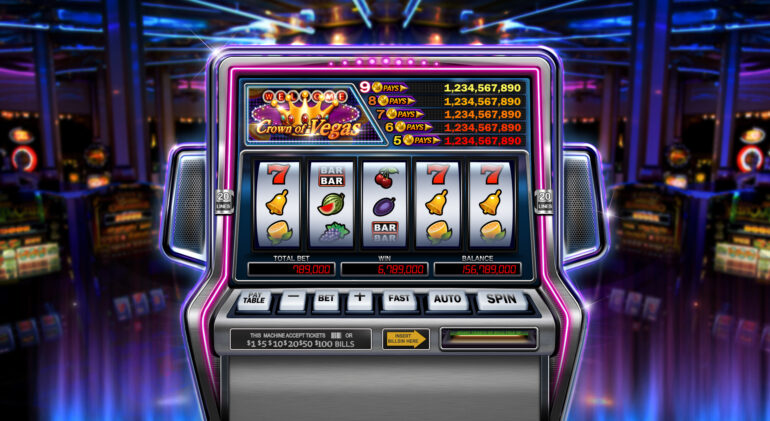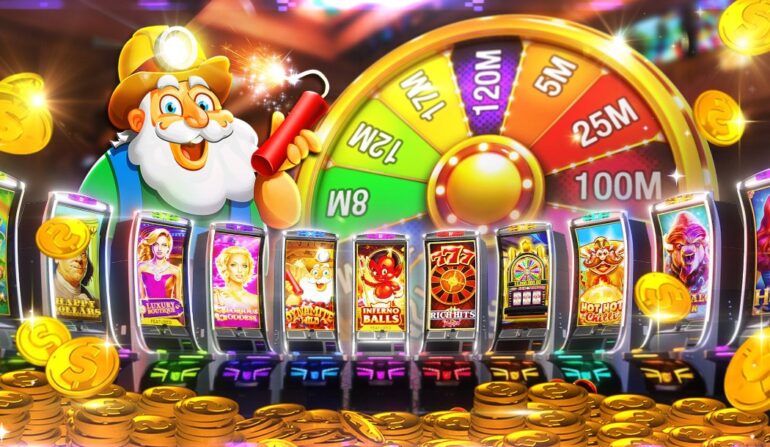
In slot machine design, casinos craft a mesmerizing experience to keep you spinning. Vibrant colors, captivating graphics, and enticing sounds trigger dopamine release and anticipation. Variable rewards, bonus features, and near-misses are strategically woven in to maintain your engagement.
Understanding how these elements influence your behavior is key to responsible play. The secrets behind slot machines are a calculated blend of psychology and design that keeps you hooked in a dance of excitement and uncertainty.
Key Takeaways
- Visual stimuli like vibrant colors and captivating graphics trigger excitement and dopamine release in the brain.
- Sound effects, especially winning sounds and near-miss cues, enhance player engagement and trigger dopamine release.
- Reward systems with variable rewards, bonus features, and progressive jackpots keep players engaged and motivated to continue playing.
- Near-misses, designed to mimic near-wins, activate reward pathways in the brain and heighten anticipation of a win.
- Addiction and behavioral conditioning through variable rewards, near-misses, and operant conditioning reinforce player behavior in slot machine gaming.
The Role of Visual Stimuli

Visual stimuli play a crucial role in the design of slot machines, influencing player engagement and overall gaming experience. The vibrant colors, flashing lights, and captivating graphics are strategically used to grab your attention and keep you immersed in the game. Casinos understand the power of visual appeal in triggering excitement and anticipation, making you more likely to continue playing.
When you see a slot machine with eye-catching visuals, your brain releases dopamine, the feel-good neurotransmitter associated with pleasure and reward. This dopamine release creates a sense of euphoria, encouraging you to keep playing in search of that next big win. The design elements on the slot machine, such as symbols and animations, are carefully selected to evoke certain emotions and keep you entertained.
Next time you sit down to play a slot machine, pay attention to how the visual stimuli impact your mood and behavior. The flashing lights and colorful graphics aren’t just for show – they’re tools used by casinos to enhance your gaming experience and keep you coming back for more.
Impact of Sound Effects
The auditory elements in slot machine design play a significant role in shaping player experience and behavior. Casinos like MMC996 strategically use sound effects to enhance the excitement and engagement of players. The captivating jingles, cheers, and chimes are carefully selected to create a sense of anticipation and reward. These sounds trigger the release of dopamine in your brain, reinforcing the pleasure of winning and encouraging you to keep playing.
Slot machines are programmed to produce specific sounds when you win, even if it’s a small prize. These celebratory sounds make you feel like a winner, regardless of the actual outcome. On the other hand, near-miss scenarios are often accompanied by different sound effects, keeping you on the edge of your seat and enticing you to try again.
The rhythmic sound of spinning reels also adds to the overall sensory experience, drawing you into the game and maintaining your focus. Casinos understand the power of sound in influencing your emotions and decisions, ultimately keeping you spinning those reels.
Influence of Reward Systems

Engaging with different reward systems in slot machine design can significantly influence player behavior and decision-making processes. Casinos strategically design these reward systems to keep you spinning the reels for longer periods.
Here’s how reward systems impact your slot machine experience:
- Variable rewards ─ Slot machines often utilize variable reward schedules, where the amount and frequency of rewards vary unpredictably. This unpredictability keeps you engaged, as you never know when the next big win might come.
- Bonus features ─ Many slot machines offer enticing bonus features that provide additional rewards beyond the base game. These features can include free spins, mini-games, or other interactive elements that increase excitement and potential payouts.
- Progressive jackpots ─ Progressive jackpot slots pool a small portion of each bet to a continuously growing jackpot. This system motivates players to keep spinning in hopes of hitting that life-changing jackpot.
Psychology of Near-Misses
Near-misses in slot machine gaming trigger a psychological response that can influence your behavior significantly. When the symbols on the reels almost line up for a jackpot, your brain interprets this as a near-win rather than a loss. This near-miss activates the same reward pathways in your brain as an actual win, leading to a surge of dopamine that keeps you coming back for more.
The anticipation of a win is heightened, creating a sense of excitement and encouraging you to keep spinning in hopes of achieving that elusive jackpot. Casinos capitalize on this psychological phenomenon by designing slot machines with near-miss features intentionally. These near-misses create a feeling of almost winning, tricking your brain into thinking that a big win is just around the corner.
As a result, you’re more likely to continue playing, chasing that feeling of victory. Understanding the psychology behind near-misses can help you make more informed decisions when playing slot machines, allowing you to enjoy the game responsibly without falling into the trap of chasing losses endlessly.
Addiction and Behavioral Conditioning

Understanding the powerful influence of addiction and behavioral conditioning in slot machine gaming is crucial for making informed decisions and maintaining responsible play. Casinos leverage these psychological mechanisms to keep players engaged, often leading to excessive gambling habits. Here’s why these factors are so influential:
- Variable rewards ─ Slot machines use a variable ratio schedule, where the rewards aren’t predictable. This unpredictability keeps you hooked, as your brain associates the act of spinning with a potential win, triggering the release of dopamine.
- Near-misses ─ Near-misses on slot machines create an illusion of almost winning, activating the brain’s reward pathways. This near-win scenario fuels the desire to continue playing, as you feel you’re close to a big win.
- Operant conditioning ─ Slot machines are designed to reinforce certain behaviors through rewards. The intermittent reinforcement of small wins conditions you to keep spinning in the hopes of hitting the jackpot.
Conclusion
In conclusion, the psychology behind slot machine design is a powerful tool used by casinos to keep players engaged and coming back for more.
Visual stimuli, sound effects, reward systems, near-misses, and behavioral conditioning all play a role in creating an addictive experience.
By understanding these tactics, you can be more aware of how casinos manipulate your behavior and make more informed decisions when it comes to gambling.
Stay vigilant and gamble responsibly.
